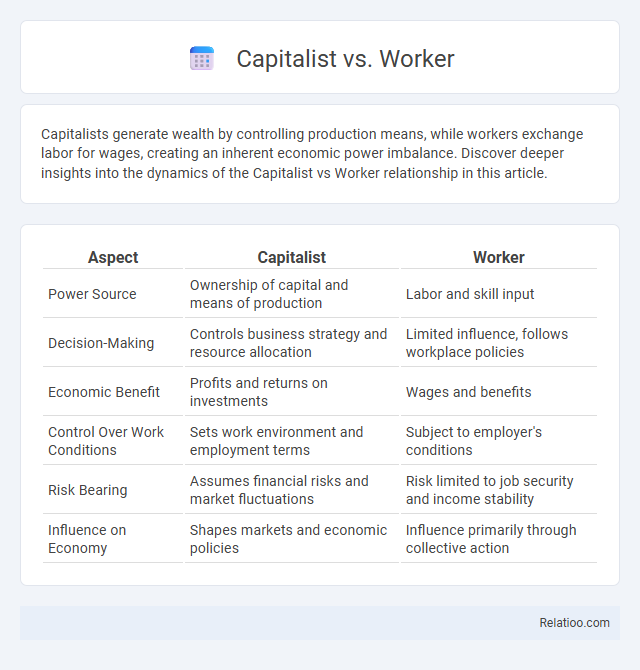Capitalists generate wealth by controlling production means, while workers exchange labor for wages, creating an inherent economic power imbalance. Discover deeper insights into the dynamics of the Capitalist vs Worker relationship in this article.
Table of Comparison
| Aspect | Capitalist | Worker |
|---|---|---|
| Power Source | Ownership of capital and means of production | Labor and skill input |
| Decision-Making | Controls business strategy and resource allocation | Limited influence, follows workplace policies |
| Economic Benefit | Profits and returns on investments | Wages and benefits |
| Control Over Work Conditions | Sets work environment and employment terms | Subject to employer's conditions |
| Risk Bearing | Assumes financial risks and market fluctuations | Risk limited to job security and income stability |
| Influence on Economy | Shapes markets and economic policies | Influence primarily through collective action |
Understanding Capitalism: Basic Concepts
Capitalism is an economic system where capitalists own the means of production and workers sell their labor for wages, creating a dynamic of labor exploitation. Exploitation occurs when capitalists extract surplus value from workers' labor, generating profit by paying less than the labor's actual worth. Understanding basic concepts such as private property, wage labor, and profit maximization is essential to analyze the power imbalance inherent in capitalist economies.
The Role of Capitalists in the Economic System
Capitalists play a crucial role in the economic system by providing the necessary capital, resources, and investment to drive production and innovation, creating jobs and generating wealth. They control the means of production and often maximize profits by leveraging labor, leading to debates about exploitation when workers receive wages lower than the value they contribute. Understanding your position in this dynamic helps clarify economic relationships and potential for equitable outcomes.
Who are the Workers? Defining the Workforce
Workers constitute the labor force that drives production across industries, encompassing individuals who sell their time and skills in exchange for wages. Your workforce includes employees ranging from skilled artisans and factory operatives to service providers and knowledge workers, all contributing to economic output. Understanding the diverse roles within your labor pool clarifies the dynamics between capital owners and those whose labor generates value.
Historical Origins of the Capitalist-Worker Relationship
The capitalist-worker relationship originated during the Industrial Revolution when the rise of factories shifted production from artisanal workshops to mass manufacturing, creating a clear division between capital owners and laborers. Capitalists accumulated wealth by controlling the means of production, while workers sold their labor under conditions often marked by exploitation, such as low wages and poor working conditions. This dynamic laid the foundation for modern economic class structures and conflicts inherent in capitalist economies.
Power Dynamics: Ownership vs. Labor
Capitalist power stems from ownership of capital and means of production, enabling control over resources, decision-making, and profit distribution. Workers possess labor power, selling it to capitalists for wages while lacking control over production processes or outcomes. This power imbalance creates exploitation, where capitalists extract surplus value from workers' labor, reinforcing systemic inequality within capitalist economies.
Wage Systems and Income Inequality
Wage systems often reflect a power imbalance where capitalists control means of production, setting compensation that may not equate to the value generated by workers, leading to systemic exploitation. Income inequality intensifies as capitalists accumulate surplus value from labor, while workers receive wages insufficient to bridge the gap between effort and earnings. Your awareness of these dynamics can illuminate the structural challenges in achieving equitable economic outcomes within capitalist frameworks.
Workplace Rights and Labor Movements
Workplace rights are fundamental in addressing the exploitation inherent in capitalist labor relations, where capitalists prioritize profit extraction from workers' labor. Labor movements have historically fought to secure fair wages, safe working conditions, and collective bargaining rights to counterbalance the power asymmetry between workers and capital owners. These movements catalyze legal reforms and institutional protections that limit exploitation and promote social justice within capitalist economies.
Productivity, Profits, and Exploitation
Capitalists generate profits by owning the means of production, leveraging worker productivity to maximize output while minimizing labor costs. Workers increase productivity through their labor, yet often receive wages that do not equate to the full value of their contribution, enabling capitalists to extract surplus value. This disparity between worker productivity and compensation forms the basis of exploitation, where profits are derived from the unpaid labor inherent in capitalist production.
Modern Challenges: Automation and Gig Economy
Automation and the gig economy have reshaped the capitalist-worker dynamic by intensifying exploitation risks through unstable employment and reduced labor bargaining power. Capitalists leverage technology to lower labor costs, often replacing traditional jobs with automated systems, while gig workers face income volatility and lack of benefits. This creates systemic challenges in labor rights, wage security, and social protections that modern economies must address to ensure equitable growth.
The Future of Capitalist-Worker Relations
The future of capitalist-worker relations hinges on evolving dynamics of power, technology, and labor rights, with automation and AI reshaping job markets and worker agency. Increasing emphasis on sustainable business models and social equity pressures capitalists to adopt more inclusive practices, potentially reducing exploitation through fair wages and improved working conditions. Emerging policies advocating for universal basic income and labor protections signal a transformative shift towards balancing capital accumulation with worker welfare.

Infographic: Capitalist vs Worker
 relatioo.com
relatioo.com